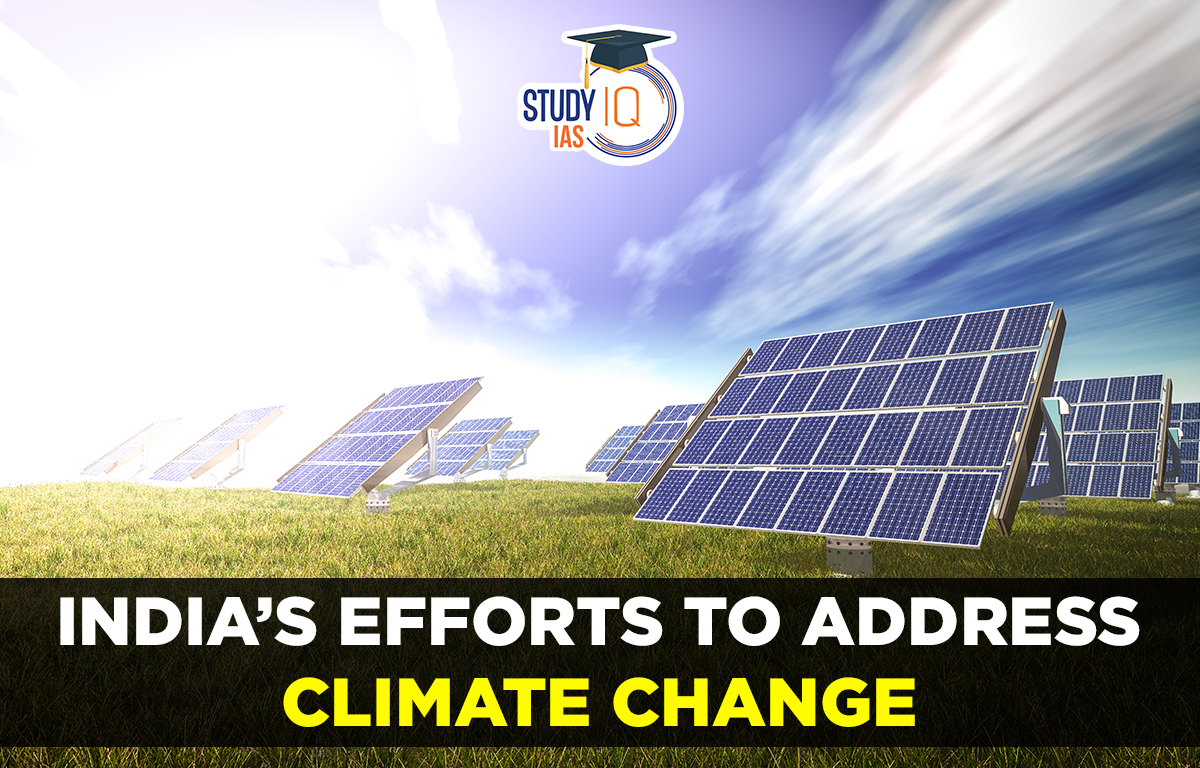| Long-Term Low-Carbon Development Strategy (LT-LEDS) |
- In November 2022, India has submitted its LT-LEDS at the UNFCCC’s COP27 in Egypt’s Sharm el-Sheikh.
- It is India’s long-term strategy of achieving net-zero emissions by 2070.
- It rests on seven key transitions to low-carbon development pathways:
- Low Carbon Development of Electricity Systems
- Integrated, Efficient, Inclusive, Low-Carbon Transport Systems
- Promoting Adaptation in Urban Design and Sustainable Urbanization
- Low-carbon Industrial systems
- CO2 Removal and Related Engineering Solutions
- Enhancing Forest and Vegetation Cover.
|
| India’s Updated NDCs (Nationally Determined Contributions) |
- In August 2022, India updated its NDCs to UNFCCC, under which India has promised three main targets for 2030:
- 45 per cent reduction in emission intensity (emission per unit of GDP) from 2005 levels.
- 50 per cent share of renewables in electricity generation.
- Creation of 2.5 to 3 billion tonnes of additional carbon sink through forests.
|
| Mission LiFE |
- Mission LiFE is an India-led global mass movement which aims to nudge individual and collective action to protect and preserve the environment.
- Its objectives include the following:
- To mobilize at least 1 billion Indians and other global citizens to take individual and collective action for protecting and preserving the environment in the period 2022 to 2027.
- Within India, at least 80% of all villages and urban local bodies are aimed to become environment-friendly by 2028.
|
| National Action Plan on Climate Change (NAPCC) |
- It was launched in 2008 by the Prime Minister’s Council on Climate Change.
- It includes 8 national missions to address the challenges of climate change:
- National Solar Mission
- National Mission for Enhanced Energy Efficiency
- National Mission on Sustainable Habitat
- National Water Mission
- National Mission for Sustaining the Himalayan Ecosystem
- National Mission for A Green India
- National Mission for Sustainable Agriculture
- National Mission on Strategic Knowledge for Climate Change
|
| The National Adaptation Fund for Climate Change (NAFCC) |
- It was established to support adaptation activities in the States and UTs that are vulnerable to the adverse effects of climate change.
- NAFCC is implemented in project mode and till date, 30 projects have been sanctioned in 27 States and UTs.
- As a result of various actions undertaken, India has achieved reduction of 24% in emission intensity of its GDP between 2005 and 2016
|
| Action plans by States and UTs |
- Thirty-four States /UTs have prepared and some have updated their State Action Plan on Climate Change (SAPCC) in line with NAPCC taking into account the State-specific issues relating to climate change.
- These SAPCCs outline sector-specific and cross-sectoral priority actions, including adaptation and climate resilient infrastructure.
|
| International Coalitions |
- Apart from resolutely addressing climate change domestically, India has launched international coalitions such as:
- International Solar Alliance (ISA): Its objective is to increase the use of solar energy in member countries through international cooperation and shared resources.
- Coalition for Disaster Resilient Infrastructure (CDRI): Its objective is to promote investment in infrastructure that is resilient to natural disasters and climate change, thus reducing the economic and human impact of such disasters.
- Infrastructure for Resilient Island States (IRIS): To support the development of infrastructure in small island developing states that is sustainable, resilient, and better able to withstand the impacts of climate change and natural disasters.
- Green Grids Initiative—One Sun One World One Grid (GGI-OSOWOG): Its objective is to promote the development of an interconnected global grid for renewable energy, specifically solar power, to enable the sharing of clean energy across borders and increase access to sustainable energy for all.
- The Leadership Group for Industry Transition (LeadIT): It is a business-led initiative that encourages companies to adopt sustainable business practices and low-carbon technologies.
|
| International frameworks, conventions, and treaties |
- India is a party to several international frameworks, conventions, and treaties related to climate change, including:
- United Nations Framework Convention on Climate Change (UNFCCC): This is a global treaty signed in 1992 to stabilize greenhouse gas concentrations in the atmosphere and mitigate the impacts of climate change.
- Paris Agreement: A global agreement signed in 2015 under the UNFCCC to limit global warming to well below 2°C above pre-industrial levels and pursue efforts to limit it to 1.5°C.
- Kyoto Protocol: An international treaty signed in 1997 that sets targets for reducing greenhouse gas emissions by developed countries. India has signed and ratified the protocol as a developing country.
- Montreal Protocol: A global treaty signed in 1987 to protect the ozone layer by reducing the production and consumption of ozone-depleting substances.
- Convention on Biological Diversity (CBD): This is a global treaty signed in 1992 to conserve biological diversity, promote sustainable use of its components, and ensure the fair and equitable sharing of benefits arising from the use of genetic resources.
- United Nations Convention to Combat Desertification (UNCCD): This is a global treaty signed in 1994 to combat desertification and mitigate the effects of drought in countries experiencing serious drought and/or desertification, particularly in Africa.
|


 Daily Quiz 01 July 2025
Daily Quiz 01 July 2025
 China, Pakistan and Bangladesh Trilatera...
China, Pakistan and Bangladesh Trilatera...
 US Pulls Funding from GAVI-Global Vaccin...
US Pulls Funding from GAVI-Global Vaccin...





















